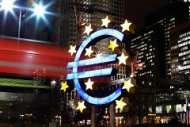At its monetary policy meeting on Thursday, the European Central Bank's (ECB) President Mario Draghi is widely expected to give the euro zone's sluggish economy a boost and halt a growth-sapping fall in prices.
In the second of our series looking at the tools at Draghi's disposal, we examine the possibility of interest rate cuts - potentially into negative territory.
All attempts thus far seem to have been focused on allowing banks to recapitalize from their betting losses on housing. But the banks need those depositors in order to create new money via loans. Pushing deposits OUT of the banks by removing the incentive to save seems counter productive.
All attempts thus far seem to have been focused on allowing banks to recapitalize from their betting losses on housing. But the banks need those depositors in order to create new money via loans. Pushing deposits OUT of the banks by removing the incentive to save seems counter productive.
What is it?
The ECB's only job - the one it was created for - is to control inflation in the 18-country euro zone, unlike the U.S. Federal Reserve which has the power to generate jobs in its charter.
Although it is only allowed to keep a lid on rising or falling price rises, the bank also makes sure other economic conditions - such as employment or economic growth - don't have a negative impact on inflation.
The ECB's biggest instrument of control is setting rates. The main rate - known as the refinancing rate - is how much the ECB charges for its loans, and determines how much banks charge each other for loans. Many rates, such as those paid on a mortgage or savings account, are linked to this.
Another interest rate is the deposit rate, which is paid by the central bank to other banks for holding their deposits overnight.
Why cut rates?
A cut by the ECB to the refinancing rate - which is currently at 0.25 percent - makes borrowing cheaper for banks, thereby boosting lending, spending, business investment and job creation.
And Europe's economy certainly needs all the help it can get. Gross domestic product (GDP) for the euro zone came in at just 0.2 percent in the first quarter, and there are ongoing concerns about the region's low inflation.
However, in spite of the record-low interest rate, lending to small and medium sized businesses - the backbone of the euro zone economy - has remained stubbornly low and continued to fall in April.
Another option open to the ECB is a cut in the deposit rate it pays banks to store money with it, which already stands at zero. As such, a negative rate would see banks charged for parking their cash at the ECB, giving them an incentive to move their money into other assets, such as loans to households and businesses.
A cut to either or both rates could also help weaken the euro, which has gained 4 percent against the dollar over the past year. A stronger single currency makes euro zone exports more expensive, thereby hindering the region's efforts to grow.
Why not?
There are concerns that cuts to both interest rates have already been priced in to the market, which would significantly reduce their impact.
One issue with a cut to the refinance rate is that it doesn't leave much room for maneuver. If it is cut to yet another record low, the ECB would not have much scope to cut further before it turns negative.
If the ECB crossed the threshold into negative deposit rates, it would be the first major central bank to do so - meaning it had moved into uncharted territory.
There are worries that such a move could hit the banking sector. If banks pass the negative rates onto customers, households and businesses could opt to hold onto their cash rather than deposit it in a bank. And if banks don't pass on rates below zero, their profitability could be hit as a result.
And even if the banks did offer more loans, companies may still be reluctant to take on more debt given the widespread uncertainty about the strength of the economy.
What the experts think
A large number of economists are expecting a cut to both the refinance rate - by between 10-15 basis points - and the deposit rate - by 10 basis points - to be announced by the ECB this Thursday.
Carsten Brzeski, senior economist at ING, said cuts to both rates will be unveiled, along with additional liquidity measures.
"This would allow the ECB to demonstrate its determination to act and weaken the euro without entering too much uncharted territory," he wrote in a note.
Jennifer McKeown, economist at Capital Economics, said rate cuts were unlikely to be a "game-changer", although she added: "The reduction in the deposit rate below zero might have an 'announcement effect' on the euro given that the bank is sailing into uncharted waters."
Deutsche Bank economists led by Gilles Moec agreed, referring in a recent note to a negative deposit rate cut as "symbolic more than anything else."
"A negative deposit rate is not a policy that has much history in global central banking. There are potential costs," they wrote in a note. "We suspect that caution will limit the policy to a small negative deposit rate."
ref https://au.finance.yahoo.com/news/eyes-ecb-negative-rate-looms-051503678.html

Comments